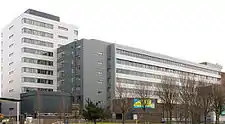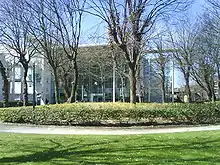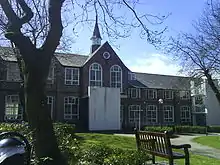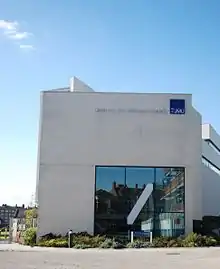Liverpool John Moores University
Liverpool John Moores University (abbreviated LJMU) is a public research university in the city of Liverpool, England. The university can trace its origins to the Liverpool Mechanics' School of Arts, established in 1823.[3] This later merged to become Liverpool Polytechnic. In 1992, following an Act of Parliament, the Liverpool Polytechnic became what is now Liverpool John Moores University.[4] It is named after Sir John Moores, a local businessman and philanthropist, who donated to the university's precursor institutions.
 Coat of Arms | |
| Motto | Latin: Audentes fortuna juvat |
|---|---|
Motto in English | Fortune favours the bold |
| Type | Public |
| Established | 1823 - Liverpool Mechanics' School of Arts 1992 - Liverpool John Moores University |
| Chancellor | Sir Brian Leveson |
| Vice-Chancellor | Ian Campbell |
Administrative staff | 1,095[1] |
| Students | 24,030 (2018/19)[2] |
| Undergraduates | 19,465 (2018/19)[2] |
| Postgraduates | 4,655 (2018/19)[2] |
| Location | , England , United Kingdom 53.403°N 2.970°W |
| Campus | Urban |
| Colours | Navy blue Lime green |
| Affiliations | University Alliance EUA NWUA Northern Consortium |
| Website | www |
 | |
The university had 24,030 students in 2018/19, of which 19,465 are undergraduate students and 4,655 are postgraduate,[2] making it the 35th largest university in the UK by total student population.
It is a member of the University Alliance, the Northern Consortium and the European University Association.
History
Origins
Founded as a small mechanics institution (Liverpool Mechanics' School of Arts) in 1823, the institution grew over the centuries by converging and amalgamating with different colleges, including the F.L.Calder School of Domestic Science,[5] the City of Liverpool C.F. Mott Training College, before eventually becoming Liverpool Polytechnic in 1970.[6] The University also has a long history of providing training, education and research to the maritime industry, dating back to the formation of the Liverpool Nautical College in 1892.
The institution then became a university under the terms of the Further and Higher Education Act 1992 under the new title of "Liverpool John Moores University". This new title was approved by the Privy Council on 15 September 1992. The university took its name from Sir John Moores, the founder of the Littlewoods empire. Moores was a great believer in the creation of opportunity for all, which embodies the ethos of LJMU in providing educational routes for people of all ages and from all backgrounds. This belief led Sir John Moores to invest in the institution and facilities, such as the John Foster Building (housing the Liverpool Business School), designed by and named after leading architect John Foster.[6] With the institution's backgrounds dating back as far as 1823, many of the university buildings date back also, with aesthetically pleasing Georgian and Victorian buildings found on a few of the campuses.[1]
Present day

LJMU now has more than 24,000 students [7] from over 100 countries world-wide, 2,400 staff and 250 degree courses.[8] LJMU was awarded the Queen's Anniversary Prize in 2005.[9]
Currently, Liverpool John Moores University is receiving more applications than previously seen; according to data in 2009, the total number of applications submitted to LJMU was 27,784.[10]
On 14 April 2008, Brian May was inducted into the university as the fourth Chancellor of Liverpool John Moores University. May is also the lead guitarist for the rock band Queen. He replaced outgoing Chancellor Cherie Booth QC, wife of former Prime Minister Tony Blair. Honorary fellows in attendance at the ceremony included Sir Patrick Moore and Pete Postlethwaite.[11] May was succeeded as Chancellor in 2013 by Sir Brian Leveson.
LJMU is a founding member of the Northern Consortium, an educational charity, owned by eleven universities in the north of England.
Campuses
The university is based primarily on three campuses:
- City Campus, housing buildings from many faculties in and around Liverpool city centre
- Mount Pleasant Campus, in the city centre, home to the faculty of Business and Law
- I M Marsh Campus, in Aigburth housing the Education, Community and Leisure faculty
Libraries

There are currently three libraries based at the three campus sites operated by LJMU. The two largest and more modern LRC facilities are the Avril Robarts library which is based on the City campus and used mainly (but not exclusively) by students studying on the city campus, in particular the Byrom Street and Marybone students. The Aldham Robarts LRC (which is based on the Mount Pleasant campus) is used mainly by students at the Mount Pleasant campus, this campus includes the faculty of Business and Law but student based closely to the LRC on a range of courses also use this facility. The third LRC is sited on the IM Marsh campus in Aigburth and is used exclusively (due to location outside the City centre) by students at this campus, and is the only library not to offer 24hr support and has a period students are unable to withdraw books due to Christmas holidays.
There are more than 68,500 books in the LRCs' collections, with 1,630 work spaces available for students 24 hours a day. In addition to this there are over 16,000 e-books and 5,000 e-journals available.[12] It is a member of the Libraries Together: Liverpool Learning Partnership (evolved from Liverpool Libraries Group) which formed in 1990. Under which, a registered reader at any of the member libraries can have access rights to the other libraries within the partnership.[13]
The Aldham Robarts library is situated on Maryland Street at the heart of the Mount Pleasant Campus and right opposite the Students' Union, Aldham Robarts caters mainly for the Faculty of Business and Law and the Faculty of Media, Arts and Social Science.
Avril Robarts Library is located on Tithebarn Street on City Campus, and covers three faculties: Faculty of Health and Applied Social Sciences, the Faculty of Science and the Faculty of Technology and Environment,
IM Marsh Campus library services the IM Marsh campus at Aigburth and covers the Faculty of Education, Community and Leisure which is situated at this site.
Tom Reilly Building
The Tom Reilly Building houses the School of Sports and Exercise Sciences and the School of Natural Sciences and Psychology, which are both part of the Faculty of Science.[14] Some 8,000 students use the building which is located at LJMU's City Campus on Byrom Street. The five storey, 6,493 m2 (69,890 sq ft) building was completed in November 2009[14] and opened in March 2010 by Liverpool F.C. captain Steven Gerrard.[15] The building provides sports and science facilities including; appetite laboratories, psychology testing labs, neuroscience labs, an indoor 70-metre running track, force plates, caren disc, physiology suites, a DEXA scanner, a driving simulator and a chronobiology lab.[14]
Organisation and structure
Faculties
The university is organised into five faculties (which are each split into schools or centres), most of the faculties are based at a particular campus site however, with many joint honours degrees and some conventional degrees, the faculties overlap meaning students' degrees are from both faculties. The five faculties are:
- Faculty of Business & Law
- Liverpool Business School
- School of Law
- Faculty of Arts, Professional and Social Studies
- Liverpool School of Art and Design
- Liverpool Screen School
- School of Education
- School of Humanities and Social Science
- School of Justice Studies
- Institute of Culture Capital
- Faculty of Health
- School of Nursing and Allied Health
- Public Health Institute
- Faculty of Science
- School of Natural Sciences and Psychology
- School of Pharmacy and Biomolecular Sciences
- School of Sport and Exercise Sciences
- Faculty of Engineering and Technology
- Astrophysics Research Institute
- Department of Applied Mathematics
- Department of the Built Environment
- Department of Civil Engineering
- Department of Computer Science
- Department of Electronics and Electronic Engineering
- Department of Maritime and Mechanical Engineering
- LJMU Maritime Centre
- Centre for Entrepreneurship
Governance
Academic profile
LJMU is highly ranked for teaching and research in Sports and Exercise Sciences.[16][17] The Higher Education Funding Council for England (HEFCE) awarded LJMU £4.5 million over five years for the establishment of a Centre for Excellence in Teaching and Learning (CETL). The CETL award recognises LJMU's record for Physical Education, Dance, Sport and Exercises Sciences. LJMU is the only United Kingdom university to be awarded an Ofsted Grade A in Physical Education and it is also the premier institution for both teaching and research in Sport and Exercise Sciences.[17]
Business School
Liverpool Business School (LBS) is located in the Redmonds Building on the Mount Pleasant Campus and has over 2,500 students and 100 academics.[18]
LBS offers undergraduate, postgraduate (including an Executive MBA) and research based programmes.[18] Research areas include International Banking, Economics and Finance, Sustainable Enterprise, Public Service Management, Development of Modern Economic Thought, Performance Management, Marketing, Project Management, and Market Research.[19]
Research

In the 2001 Research Assessment Exercise (RAE), LJMU reported notable research strengths in general engineering and sports-related sciences. By the 2008 RAE, LJMU was the top-performing post-92 university for Anthropology, Electrical and Electronic Engineering, General Engineering, Physics (Astrophysics) and Sports-Related Studies. According to the UK Research Assessment Exercise 2014 (RAE 2014), LJMU every unit of assessment submitted was rated as at least 45% internationally excellent or better.[20] In 2012, the university's scientist published notable research suggesting that the dinosaur's extinction may have been caused by increased methane production from the dinosaurs, with some informally saying that dinosaurs "farted" their way to extinction.[21]
Rankings
| National rankings | |
|---|---|
| Complete (2021)[22] | 66 |
| Guardian (2021)[23] | 70 |
| Times / Sunday Times (2021)[24] | 85 |
| Global rankings | |
| ARWU (2020)[25] | 701–800 |
| QS (2021)[26] | 801-1000 |
| THE (2021)[27] | 401–500 |
| British Government assessment | |
| Teaching Excellence Framework[28] | Silver |
Liverpool John Moores University was included in the new 2013 Times Higher Education 100 under 50, ranking 72 out of 100. The list aims to show the rising stars in the global academy under the age of 50 years.[29]
First Destination Survey results show that 89% of LJMU graduates are in employment or undertaking postgraduate study within six months of graduating.[1]
Student life
Students' Union
Students at the University are represented by the Liverpool Students' Union.
Representation for all students is central and is conducted by executive officers elected annually. In most cases, these students will be on a sabbatical from their studies. The election process is normally contested in mid April, successful candidates assuming office the following academic year.
Sports

Liverpool John Moores University has BUCS-registered teams in badminton, basketball, cricket, football, cycling, hockey, netball, rugby league, rugby union, tennis, volleyball, swimming and American football. Many of the sports teams compete in BUCS competitions. Liverpool Students' Union has 15 BUCS sports, from which 36 teams run, catering for over 800 athletes. In recent years, LJMU students have competed for BUCS representative squads, in national finals and at World University Championships.[30] In addition, the Students' Union also runs intramural sports leagues.

The University also enjoys success at National and World level. Gymnast Beth Tweddle studied at LJMU and has achieved national, Commonwealth, European and World medals whilst also competing at the Olympic Games.
Every year the university sports compete for 'The Varsity Cup' in the inter-university derby, Liverpool John Moores University Vs. University of Liverpool. The competing sports include: badminton, basketball, hockey, football, netball, volleyball, swimming, tennis and the snowriders racing team.
The IM Marsh Campus houses the University's main sporting facilities. The campus is home to the Faculty of Education, Community and Leisure (ECL) and has around 2,000 students each year. In addition to sports science labs and a learning resource centre, the campus includes the following sporting facilities:
- Large sports hall
- 2 Full sized hockey astropitchs
- 2 Fully equipped fitness suite/gymnasium
- Full sized football pitches
- Five a side football pitches
- 8 Badminton courts
- 2 Basketball courts
- 8 Tennis courts
- 3 Netball courts
- Climbing wall
- Full sized rugby pitches
- Dance studios
Notable alumni

 President Mohamed Nasheed, 4th President of the Maldives
President Mohamed Nasheed, 4th President of the Maldives



- Caroline Aherne (actress, comedy writer, The Royle Family)
- Martyn Bernard (2010 European Athletics Championships bronze medalist high jumper)
- Rebecca Bisland (Republic of Ireland international footballer)
- Rachel Brown (England women's national football team Goalkeeper)
- Stephen Crowe (composer)
- Bambos Charalambous (MP)
- Stephen Byers (MP)
- Julian Cope (musician, author)
- Lord Elis-Thomas (Welsh politician)
- Claire Foy (actress, featured in many well-known television series, including Netflix's 'The Crown')
- Zack Gibson (professional wrestler)
- Neena Gill (MEP)
- Andreja Gomboc (astrophysicist)
- Mark Hendrick (MP)
- Christy Holly (Head Coach of Louisville Royals in the NWSL)
- George Howarth (MP)
- John Lennon (The Beatles)[31]
- Matt Lloyd (Paralympian) (Ice Sledge Hockey)
- Andy Merrifield, Marxist urban theorist
- Steve Morgan, founder of Redrow plc
- Margaret Murphy (crime writer)
- Mohamed Nasheed (4th President of the Maldives)[32]
- Martin Offiah rugby league player
- Juan Carlos Osorio (football manager)
- Tom Palin (painter)
- Roxanne Pallett (actress, known from Emmerdale)
- Les Parry: English football manager
- Steve Parry (Olympic Games bronze medalist swimmer)
- Vicky Pattison (Geordie Shore Reality personality)
- Louise Pentland [Known online as 'Sprinkle Of Glitter'] (Youtuber)
- Michael Rimmer (2010 European Athletics Championships silver medalist 800m runner)
- Gareth Roberts (writer, Doctor Who and The Sarah Jane Adventures)
- James Roby (St Helens R.F.C. rugby player)
- Philip Selway (musician, Radiohead)
- Andrew Stunell (MP)
- Tegan Summer (actor)
- Gemma Tumelty (52nd President of NUS)
- Beth Tweddle MBE Olympic medalist(gymnast)
- Andi Watson (cartoonist)
- Laura Watton (Original English-language manga artist)
- Hannah Whelan (gymnast)
- Ieuan Wyn Jones (Welsh politician)
See also
References
- "Liverpool John Moores University | Push university guide | University rankings". Push.co.uk. 27 July 2010. Archived from the original on 28 September 2011. Retrieved 23 October 2011.
- "Where do HE students study?". Higher Education Statistics Agency. Retrieved 1 March 2020.
- "UK Education and Studying in the UK - Liverpool John Moores University". ukeas.com.
- "The History of our Buildings". Liverpool Institute for Performing Arts. Archived from the original on 24 November 2015. Retrieved 28 November 2015.
- "F. L. Calder College of Domestic Science". Merseyside at War 1914 - 1918. Retrieved 14 June 2017.
- "A brief history of LJMU". Liverpool John Moores University. 27 June 2010. Retrieved 22 July 2016.
- "About Liverpool John Moores University". www.ljmu.ac.uk. Retrieved 15 February 2019.
- https://www.ljmu.ac.uk/about-us/about-liverpool-john-moores-university
- Neil Grant (10 March 2006). "Queen's Anniversary Prize". Liverpool John Moores University. Retrieved 23 October 2011.
- "Profile: Liverpool John Moores University". The Sunday Times. Retrieved 16 July 2014.
- Shonagh Wilkie (17 April 2008). "News Update". Liverpool John Moores University. Archived from the original on 28 September 2011. Retrieved 23 October 2011.
- Jon Morris (19 September 2011). "Library Services and Facilities". Liverpool John Moores University. Retrieved 23 October 2011.
- "Liverpool Libraries Together". liv.ac.uk. Archived from the original on 17 December 2012. Retrieved 3 September 2014.
- "Tom Reilly Building Data". Liverpool John Moores University. Retrieved 8 October 2010.
- "Liverpool FC's Steven Gerrard 'blown away' by Liverpool John Moores university's £25m new sports science base". Liverpool Echo. Retrieved 8 October 2010.
- "Education UK – Innovative. Individual. Inspirational". Educationuk.org. Retrieved 23 October 2011.
- Helena Eaton (2 September 2011). "Sport at LJMU". Liverpool John Moores University. Retrieved 23 October 2011.
- "Welcome to Liverpool Business School". Archived from the original on 11 February 2009. Retrieved 19 July 2008.
- "Liverpool Business School Research". Archived from the original on 18 September 2008. Retrieved 19 July 2008.
- "RAE 2014 – World Leading Research at LJMU". UK Research Assessment Exercise 2014. Retrieved 2 June 2015.
- "Gone with the wind - Rethink 'big bang' theory". www.dailytelegraph.com.au. 7 May 2012. Retrieved 6 July 2019.
- "University League Table 2021". The Complete University Guide. 1 June 2020.
- "University league tables 2021". The Guardian. 5 September 2020.
- "The Times and Sunday Times University Good University Guide 2021". Times Newspapers.
- "Academic Ranking of World Universities 2020". Shanghai Ranking Consultancy.
- "QS World University Rankings 2021". Quacquarelli Symonds Ltd.
- "World University Rankings 2021". Times Higher Education.
- "Teaching Excellence Framework outcomes". Higher Education Funding Council for England.
- "So far, so good: 100 under 50" (PDF). 20 June 2012. Retrieved 3 September 2014.
- "LJMU Sports Teams". Archived from the original on 19 February 2008. Retrieved 8 May 2008.
- Art Day's Night! LJMU to rename arts academy after John Lennon Liverpool Echo Retrieved 2017-01-11
- "Wathan Edhey Gothah – MDP". voteanni.com. Retrieved 3 September 2014.
External links
| Wikimedia Commons has media related to Liverpool John Moores University. |

